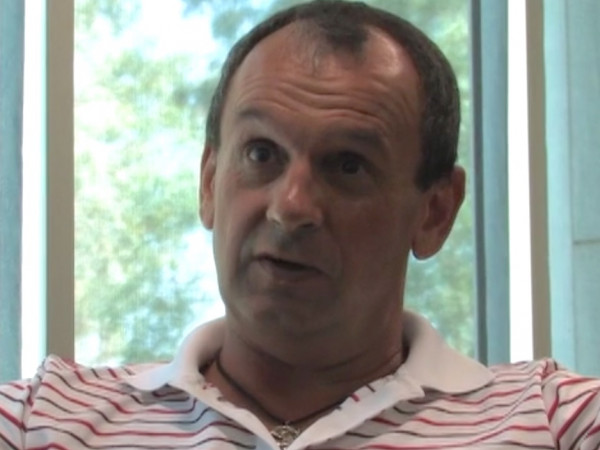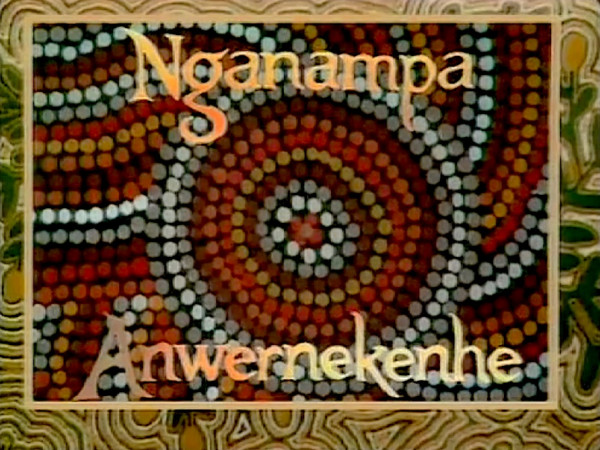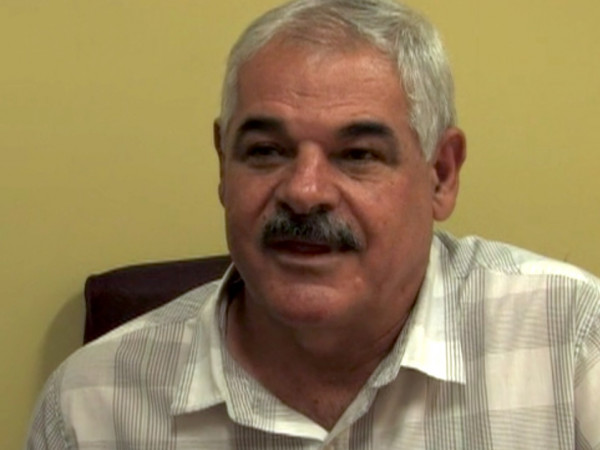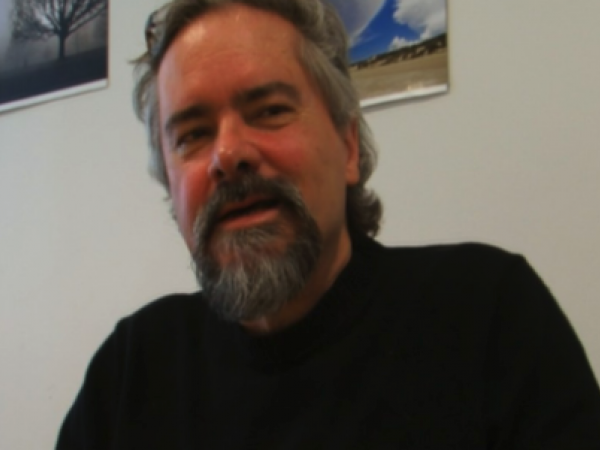Dion Weston
‘You’ve got to see Imparja in a bigger picture…’
I think the film in as well as you can stack that much stuff into an hour or an hour programme - I think I think it was about an hour - look, it covered the gamut of the issues, it dealt with BRACS, it dealt with some of the stuff going on down at Yuendumu…
I do think that it's probably a little bit, I mean, you'd have to say it's a very naive style documentary. I wouldn't say it's that ‘schmick’, and the production values were, you know, in in retrospect, were… pretty loose, pretty crude.
I think it could have been more, you know, tighter if it had been, you know, it could have been a bit more or more slick. But again, you know, it's just important that some of it was documented that we do have that documentary record because there's not much of it otherwise, I don't think.
I was, I was a technical project manager. I ended up working with CAAMA as a project manager, designing and ending up actually building the CAAMA radio network, and that was pre-satellite. So, we actually ended up having small, micro FM stations in each of the major communities: Ali Curung, Santa Teresa and Hermannsburg.
Then as that job rolled to an end, was just about the time when…Phillip [Batty] had the audacity to pop in a submission for the commercial television licence, and I really didn't have very much to do with the actual application and the process of getting it, other than I had a little bit of input into the into the budgeting and some of the costings. And yeah, I suppose it's the devil they knew - they needed someone to build the thing and they had just… I had just finished this radio network for them, and they thought, ‘Gee, well if he can do that, he can build a satellite commercial television station!’ And I don't know… I mean, it's a weird thing when you're in your early 30s, you've got a bit of bravado: ‘…I can do that!’ It was it was it was a pretty big chunk to build. And there was a huge overlay of politics on top of the whole thing - I mean, it was a, it was a fraught environment to put it to air in. So…and that was… I was blooded in the sense of having to deal with those political complexities. And hence, by the time we actually got to the point of going to air, because there was a lot of fits and starts - as to you know, there were lots of points which we were either forced to stop work or potentially it wouldn't go forwards: it may… it wasn't a guarantee, you know, laid down there that it was going to happen. And …so at some point, they went through a recruitment process for the Station Manager, the …person to actually run and run the station after it was… operating on air. And I don't know, I put my I put my hat in the ring by, just simply they said, ‘Why don't you? You should…’ So, I said, ‘OK, I'll do it…’ I didn't, I had no expectations given I had no background in commercial broadcasting, that I would get the gong. But again, they, I don't know, they … thought I looked like… well, I, I think to be to be fair, I knew more intimately than most what we were up against, in terms of getting talent to come and work in such a remote place, how you would get the technical nous and the and the expertise that, from outside to come and and ..focus on what was required in the middle of Australia - was no mean feat. So, to some degree they'd seen how I'd handled that with the politics and the …issues that were associated with actually getting the thing built. And they said, ‘OK, well, you know, more than most in terms of what we're up against, have a go at running it…’
You've got to see it within the context of the times that we were in, and there was a lot of politics going on in the background as to whether Aboriginal people, you know, really had the wherewithal to manage and do something like that. So, you've got to see, you've got to see Imparja in a bigger picture that it's not just CAAMA. It got bigger than the whole business of CAAMA, getting a television licence and producing Aboriginal programming. It got mixed up with the whole business of the bicentennial. And what would to, you know, what would Aboriginal people do with two million dollars to celebrate the fact that they lost their inheritance and, and so… well, one better way of doing it than to throw at it, at getting a commercial television licence.
You have to see it in context and you have to see in the context not only of their own aspirations as to what they were going to do with CAAMA and Aboriginal television and mitigation of cultural degradation impact, etc., but the bigger picture of how and where were Aboriginal people as a political movement nationwide, where were they heading and what were their aspirations? And to a degree, it got you know, the whole thing started to get a head of steam in its own right as it became clear that it was actually not a pipe dream. It was - it may have been Philip’s audacity to do it in the first place, but once the possibility of holding a commercial television licence in the hands of …you know, as far as I'm aware, it's the only indigenous owned commercial television station in the world. It may still be the case that it is … And from that point of view was - you're in the big league, you know, this is a licence that is the one, the same licence that Rupert Murdoch, if he owned the commercial television station, which he did have a share in one for a while. But certainly [Kerry] Packer, you know, who was a big, big name in the media environment, Channel Nine, you know, they held the same type of licence.
There is now NITV, which is satellite-broadcast nationally, there is nowhere in Australia you can't get access to that programme and… Nevertheless, I'm not sure how much they do on that station that is still like Nganampa Anwernekenhe - and I should add at this point that if I have any real disappointments about Imparja, it was that I don't think CAAMA really came to grips with one of Freda Glynn's strongest views, initiatives, wishes, desires of what she wanted the thing to achieve. And that was that for any regional commercial television station, you get programming that has a, a fixed amount of programmed content and then for commercial purposes….there's the what we call the interstitial components. You've got something like a, you know, 12 to 14 minutes per, per hour of interstitial content to fill.
And so there was a lot of time to fill with and appropriately ‘bath time, good time’. There were programmes about, you know, ‘don't drink and drive, don't beat your wife’… There was just a whole, whole lot of really interesting….And these were, these segments were precursors to the stuff that David Batty did with the Yuendumu kids and … some of those films that, you know, reached sort of, you know, star thing about fixing cars in the bush and all of that sort of thing. You know, there were characters that were coming, coming to the fore for … anti-grog type advertisements and stuff like that. And it was David Batty who really led the charge in that in that area, whereas CAAMA …they sort of went a different direction. They wanted to make… or they… their view about …what it was, was proper programmes, you know, half-hour, hour type series, documentaries, ‘proper’ programming. And yet I still to this day think that there was … a lot to have been gained by focusing high quality on using that 14 minutes an hour better than it was used, far better than it was used.
I still go back to that point that that's the missed opportunity, that those 14 minutes or whatever is left - three or four minutes an hour, even three or four minutes an hour, given that you've still going to have commercials for the rest of it - but they're still in that programming the opportunity to put stuff to air that really targets and is really relevant to that community.
I certainly recall the tensions of the period that you're referring to…
We had a task to do to fulfil the requirements that the shareholders of Imparja wanted, and that was that they wanted a…they wanted a television station that wasn't going to go broke, and that would actually deliver the… requirements of the licence. You know, you don't just get a licence. There's a … there are conditions to the licence. And at that point, there was a tribunal, the ABT [Australian Broadcasting Tribunal], that had some, some say and influence. And beyond the ABT, you had government, you had federal, and you had the [Northern] Territory government, and then you had the broader community. It was as much their television station as it was, you know, CAAMA’s television station. And I mean, you're pointing it, but I'm not sure it's fair to point out, point to it as being me against Freda and Phillip, because I did see their, their point of view. And we did shunt, we did try to shunt a fair amount of money their way, at a point where we were really in very early, the early phase of getting this thing off the ground, you know, commercially. There was no money to run the television station as a grant. There was a grant from the Government to pay for the satellite, but we were never given any funding to actually run Imparja as … an entity, you know, to employ people and put the television to air. There was a …I could, you could see, it could put that into perspective: Well, we should have we should have simply … Phillip had a view that, ‘Well, damn that, you should just take the money and shunt it across. And if that television station doesn't make money, then the Government should prop it up, in order that it is possible to make a lot more television programming’. And, well, that isn't an argument that I personally had the power to say, yay or nay on. There was a Board, and there was, they were, you know, other agencies that that had input into what we were supposed to be doing, and how…I suppose I’m on the pointy end of it, because I, you know, I'm the, the Station Manager as it were, but in reality I had a Board and I had other stakeholders.
There was there was a board, it wasn't just me. There were other agencies that had funded Imparja, that had some, had some say over how and why and where the money was going to go. I dare say…what would be… I think another way of looking at it, looking at that is that, I mean, I left in 1993 and an Aboriginal person took over - one of the Perkins clan. Did that change the situation in order that that, that he turned around and … went the way that Phillip…? I don't think so. In which case …isn't that just, isn't that just an argument about, not just me, but, you know, anybody that came into that role subsequent to that, and subsequent to me?
And after I departed Imparja, at some point, not to too far down the track, negotiations occurred between the the management of the Queensland RCTS, which was Townsville based, and Imparja.
Insofar as I'm aware, they were about, you know, we will… you'll get a larger part of Australia to get Imparja to be able to put Aboriginal programming to, in return for …the rest of the community getting a greater selection of of television choice as well. Personally, I think it was too early for them to do that and they shouldn't have done that.
For one thing, that meant that you had no further control over alcohol advertising, you know… that was it, that was open - from then on, it was not ever possible to curtail and contain that sort of …which during my period when we were in with Imparja, there was another very important part of what, was part of that, holding that licence. The Board, Imparja at that point made a decision, no alcohol advertising on the television. And that did that that did have …an economic impact to it. It was a cost….unquestionably.
By cutting that deal where you basically caused an overlap between Queensland and …the central footprint. That's exactly what happened. You know, instead of, instead of Aboriginal people being roughly about 25 per cent of the audience, they were very substantially the losers. And not only that, you got 2 services further diluting the audience. So, you know , but that was that was a decision that was made by Imparja with an Aboriginal, with Aboriginal CEO leadership.
I went from Imparja to run a …there was a small regional network that in South Australia that ran from Port Lincoln all the way through to Broken Hill. So it was a it was pretty vast region for a terrestrial commercial television station. We had, you know, a demographic down in in Port Lincoln that was really quite significantly different than the mining community in Broken Hill. And then you had the industrial towns of Port Pirie, Port Augusta and Whyalla. And in in those communities, I really tried to do some of the stuff that I've mentioned that we didn't quite do as well as we… we did put segments of video on because we, just about that time was the beginnings of digital television. You could shoot and put it on to a …we could put video onto a standard definition box and edit it. And as a result of that, we put boxes in each of those communities,
As soon as we got digital play of commercials, we were able to break the service area down so that we had three separate areas: we could, at the same time, we were putting a commercial to air in Port Lincoln, we could put a different one to air in the middle, and a different one to air in Broken Hill, which meant that we could then have a really, really targeted piece of video about something that was going on in Broken Hill that would bore the pants off anyone, you know, anywhere else in the service area because it was too… But you could have parochial content. And I was very proud that we did that.
And they were made into these things that were just chucked into the service, you know, so that you would you'd be in the middle of watching Neighbours or something like that, and then you get this two minute segment on something about your area. I haven't seen that done - but that came out of what we tried to do at Imparja, and I wanted to do more of, but I couldn't do it because we weren't, we were a commercial television station. It wasn't appropriate for us to be doing Aboriginal content - that really would have busted the relationship if Imparja had started making Aboriginal orientated interstitial content. So I was blocked from doing that effectively. That was the that was what CAAMA needed to do, and did do a bit, but not much. There wasn't enough of it.
And, you know, I'm seeing now that that has a lot of relevance to what we could and should be doing to stop what's happening with the disintegration of regional media. You know, we've had not only what's happened to Aboriginal people, and that problem is happening in across the board in rural Australia.
The ABC, frankly, is the only institution left where some of what I'm talking about remains relevant. They have a… they're paid to do it, they should be doing it. There should be some of the things that we've been talking about, the things that we were focusing on for Aboriginal cultural maintenance, and that I've just mentioned to you that we champion for, in some of the regional commercial stations. The ABC needs to be doing that. They need they need to diversify to get that sort of locally relevant content back on the air across their network. It is far too concentrated. There are not enough faces and voices and views and opinions relevant to regional communities and rural Australia on the ABC.




